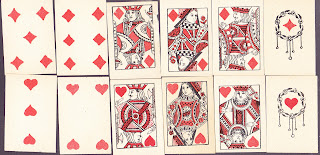We now come to the second type of mekuri karuta, the "Kurofuda", or "black cards" . Looking at the cards, it is easy to see why they got the nickname. The features of the deck are almost completely obscured by large areas of black or red paint; so much so that the only reliable method of identifying the the cards is by the shape of the blobs of paint.( Unlike the akahachi, where the features of the deck are for the most part, just blobs of paint, this deck has printed outlines, which are painted over with blobs of paint)
Sylvia Mann states that this deck is the closest deck to the portugese originals. In some ways, this is correct. When one looks closely at the cards. you can see outlines of faces, &c. which have been covered by the black paint ( if you look carefully, you can see them in the images below) . These faces do indeed reseble actual human figures ( unlike the abstract forms of the akahachi)
Another curious feature of the deck is the lack of silver overprints.
Compare: akahachi- http://anthonylesq.blogspot.sg/2012/12/akahachi-nintendo.html
Key to position of cards:
top row- 7, 8, 9, (Knave), ( Cavalier), (King)
Bottom row---Ace, 2, 3, 4, 5, 6
Swords or isu
As you can see, the colour in these images is applied more or less iin total disregard to the outlines of the figures. Note the shape of the swords. In the "Akahachi", the swords are just red lines, But here, they are more realisticaly dipicted.Also note the bird on the 2 of swords. You can also see the legs & lower half of the king's body.
Hau or batons
As with the akahachi, the main difference between the swords & batons is the colouring. Note the cavalier. The legs of his mount are visible, untouched by paint.
Ôru, or coins
The pips in this suit still remarkably look like it's european counterpart ( The star-like design in particular). If you look closely, the three court figures hold a starlike coin.
Koppu or cups
The cups in this suit are rounder and more bulbous than that of the Akahachi. You can see the lower part of the knave's body.
Compare: Akahachi


















































